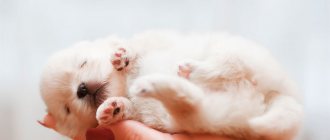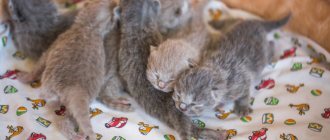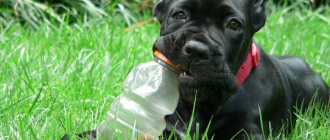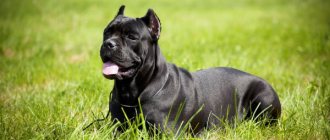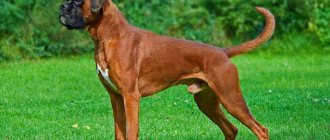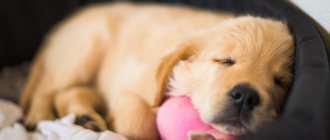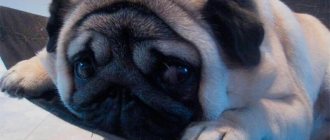Pugs are energetic, courageous, jealous, mistrustful animals, but they are good-natured, treat other dogs and cats well, love children, and nothing can make them happier than the feeling that they are part of a family. The lifespan of pugs is from 12 to 15 years.
They say about this breed “a lot in a little.”
A round head, a flattened muzzle with folds, a square body, a tail that curls into a donut - this is a pug.
This breed came to the world from China about 3000 years ago. The breed was specially bred for emperors; they acquired their final modern appearance thanks to English breeders.
And it was not for nothing that this dog was the favorite of noble people. Animals have a good-natured disposition, giving joy to their owners. The pug has a peculiar expression on its face - it’s like he’s laughing from the inside and it makes you feel touched.
This breed lives for joy and this is the secret of its enduring popularity.
In the article we will talk about how much a pug should weigh and what sizes are considered optimal for this breed, as well as what to do if deviations from the norm appear.
History of the pug breed
Pug
Although Pugs are visually somewhat reminiscent of English Bulldogs, Boxers and the now extinct Bullenbeissers from Germany, their origins are actually to be found in the East. Moreover, you will have to dig deep, because the first images of short-faced dogs that have survived to this day on ancient artifacts and mentions of them in historical documents date back to the 6th–4th centuries BC. The famous ancient Chinese philosopher and politician Confucius speaks of them as companions of the nobility traveling on chariots.
For a long time there was an opinion that another popular Chinese breed, the Pekingese, originated from pugs. However, genetic studies allow us to confidently say that family ties are built in the reverse order: long-haired dogs appeared much earlier, their direct ancestors were Lhasa Apso or Chemjo Apso, who guarded Tibetan monasteries, and pugs are either a cultivated natural mutation or the result of crossing with others short-haired breeds. Perhaps this is why Pekingese were considered exclusively imperial pets for centuries. But not everyone could afford to have pugs. This was the privilege of courtiers close to the ruler. The living conditions for the miniature dogs were truly royal, they ate much better than most ordinary subjects, often had their own chambers, servants for walking and personal security. For attempting to steal such a dog, severe punishment was imposed, including the death penalty.
Researchers suggest that the first European who had a chance to see the unusual pets of Chinese nobles was the Venetian merchant and traveler Marco Polo, who lived for seventeen years in a country exotic for a European. His “colleagues” from Holland and Portugal ended up in the Celestial Empire only two centuries later, during the era of the Great Geographical Discoveries. They brought home not only silk and spices, but also the charming Lo Chiang Tse, soon renamed to the easier-to-pronounce “pug.”
Pug puppy
The sturdy fawn-colored creatures with their sweet little faces and big eyes immediately attracted the attention of the aristocrats of the Old World. However, they played a special role in the fate of the Netherlands: the vigilance of the faithful Pompey helped William the Silent avoid death at the hands of an assassin at the height of the war for independence from Spain. Subsequently, the revolutionary leader of the Low Countries became the founder of the royal Orange dynasty, and the favorite accompanied the owner even after death - a sleeping dog was masterfully carved at the feet of the marble figure of the Dutch founding father on the lid of his sarcophagus. Pugs became a symbol and living mascot for William's heirs.
Through their efforts, the dogs came to Britain, where they quickly gained popularity among the local nobility, and subsequently dispersed to the royal courts of continental Europe. Queen Victoria, who doted on her pets, did especially much to revive interest in the breed among the British in the second half of the 19th century. Back then, “British” pugs were taller, leaner, with an elongated muzzle and had an exceptionally light color. But, as a result of the plunder of the Beijing Forbidden City during the Second Opium War by officers of the English and French armies, previously unknown black individuals came to the West. The latter are still quite rare and therefore more expensive. In general, pugs are an example of a breed whose popularity is fairly stable.
Wool shades
Pugs have short fur. You should pay attention to this when choosing a puppy. A purebred dog cannot have long hair.
The fur of these four-legged friends fits tightly and follows all the fold lines on the body.
In addition to black, a necessary condition for all animal colors is the presence of a dark mask on the face and darkening in the ear areas, which will result in a contrast with the key shade.
Existing standards for this breed indicate that dogs of this breed may also have marks on the forehead or back.
Purebred pugs have the following coat color options:
- pure black;
- different variations of beige, including sand, peach or apricot;
- as well as a silver shade of fur.
An interesting fact is that among pugs, for quite a long time, the option with a black coat was not recognized or was completely excluded.
Appearance of pugs
The ancient breed was recognized by international organizations of dog breeders at the end of the 19th century, and the official pug standard was approved only in 1987. Its main criteria are:
Weight and height
The normal weight range for an adult pug is 6.3 to 8.1 kg. The height in the standard is not clearly stated, but on average it is 25-30 cm for females and 30-33 cm for males.
General appearance
The Pug is a stocky dog with square outlines (the length of the body is equal to the height at the withers). The muscles are well developed, giving the impression of compactness and proportionality.
Color
Pugs have fawn (beige), apricot, silver or black colors. In the first three cases, a prerequisite is the clearest possible contrast between the main (light) color and the dark “mask” on the face and ears. The so-called “belt” is allowed - a dark strip of fur running along the spine from the occipital protuberance to the base of the tail, and the “diamond” - a dark spot on the forehead.
Black pug
Apricot pug
Wool
The pug's coat is short, fine, close-lying, smooth and soft to the touch. Usually has the same length throughout the body, but can be somewhat shorter on the muzzle and slightly longer in the rear of the body. Black animals have coarser coats than beige and apricot dogs.
Silver pug (white)
Fawn Pug (beige)
Head
A textbook example of a brachycephalic skull. Large, massive, rounded, but not “apple-shaped”, has no pronounced protrusions and dents, the bones of the skull are invisible. The muzzle is square, short, blunt, but not upturned, with deep symmetrical wrinkles. The forehead does not protrude above the brow ridges.
Eyes
Pug face
Dark (no whites should be visible), large, round, fairly convex, but not bulging. Set wide apart.
Nose
The bridge of the nose is small but pronounced, straight, with shortened rather than curved nasal passages. The nose is dark, in line with the eyes and visually is the center of the muzzle.
Jaws
The lower jaw is wide, the chin is well defined. For pugs, a tight overbite (no more than 3 mm) is the norm - the evenly spaced incisors of the lower jaw overlap the teeth of the upper jaw.
Neck
Strong, powerful, comb-shaped, slightly curved, length proportional to the body.
Ears
Pug ears are small in size in relation to the head, thin and very soft. Two forms are acceptable: laid forward, the internal openings of which are closed with the edges tightly pressed to the skull (“buttons”), or folded over the head, pulled back so that the inner part remains open (“roses”). First preference is given.
Torso
Short and massive, with a wide chest and well-defined, arched, set-back ribs. The topline is straight.
Forelegs
Strong, straight, of moderate length, well set under the body. The feet are neither overly elongated nor distinctly rounded, the toes are clearly separated and the nails are black.
Hind limbs
The pug's hind legs should be well developed, strong, straight, parallel to each other when viewed from behind, and of moderate length. The stifle and hock joints have clearly defined angles. The shape of the paws is elongated, but not long. The toes are well separated at the top.
Tail
The pug's tail is short, thick, densely covered with hair, set high and pressed close to the body. Twisted into a ring, with a double turn being preferred.
Movements
Springy, free, elegant, confident. The pug's gait is characterized by slight rolling movements.
Possible defects
- convex or “apple-shaped” skull;
- protruding forehead or hollows between the eyes;
- lack of bridge of nose;
- upturned or downturned nose;
- saggy jowls;
- disharmonious fold above the nose;
- lightened nose;
- narrow nostrils;
- close-set, light-colored, almond-shaped, slanted, too small, protruding or with the whites of the eyes showing;
- a twisted mouth exposing teeth and tongue;
- sagging or arched breasts;
- disproportionately long or short neck;
- long and/or fluffy coat;
- straightened joint angles.
Pet breeding
A female dog's first heat begins at 6-10 months, but a dog cannot be bred at this age - she is not yet ready to bear healthy offspring.
The minimum age suitable for breeding a pug is 15 months .
Mating takes place 10-13 days after the start of estrus in the male dog’s territory and is repeated after 2-3 days to increase the likelihood of fertilization.
Before mating, the bitch must be prepared:
- she must have all her vaccinations;
- 3-4 weeks before the expected date of mating, carry out deworming;
- bring the pet’s weight back to normal: she should not show signs of obesity or exhaustion.
NOTE!
Pregnancy lasts 63 days, it can be determined by the behavior of the bitch: she gains weight, becomes less active, and sleeps a lot.
There is a possibility that the dog will not be able to give birth on its own and will need a caesarean section, which must be taken into account in advance and try to ensure that the entire pregnancy proceeds under the supervision of a veterinarian.
Photo of an adult pug
Pug character
As noted above, all pug owners describe them as friendly and sweet companions.
Puppies are quite playful, but as they grow older, the need for active leisure time fades away, and the main joy in a pet’s life becomes quiet hours on the couch in the company of its owner. Pugs are extremely attached to people, so it is not recommended to leave them alone for a long time, so as not to provoke stress. If you are planning a vacation or another trip, feel free to entrust your pet to the care of neighbors or friends - these dogs easily make contact even with strangers who show interest and good feelings in them. The love of the “little tank” is enough even for children, but it is worth keeping an eye on their communication, since during play they can, through carelessness, seriously injure the animal’s large and bulging eyes.
Unlike other decorative breeds, pugs are calm and balanced. They are not characterized by the “spoiled child” syndrome, which can often be encountered when interacting with “ladies’” dogs. If a pug wants your attention, he will simply come and sit next to you.
Pug owners will not have to listen to their neighbors' complaints about intrusive barking, which, of course, does not guarantee a regime of silence. Your pet will constantly snore loudly, wheeze and experience bouts of flatulence. Pugs are also the absolute champions of dog snoring, which you wouldn’t suspect given their modest size. However, many consider the latter to be more of a fun feature than a drawback.
Pug trainingDoing it right
Many owners are worried that this procedure will cause pain for their pet. But these are false concerns and fears. The dogs feel quite comfortable. Sometimes irritation or allergies may occur. The main thing is to correctly and consistently perform all the steps of a pet’s simple cosmetic surgery.
The procedure for correcting the shape of the ears is as follows:
- First, it is necessary to realign the ear, paying special attention to the place where the cartilage breaks incorrectly.
- Next, fold the side edges of the ear so that they touch and point upward.
- Secure it with adhesive tape across it close to the cartilage, high enough to accurately fix the cartilage. The 10 centimeter long patch should hold the ear tightly. The main rule is not to overdo it with the force of fastening: you can disrupt blood circulation and cause pain and discomfort to the dog.
At first, you need to keep an eye on the puppy and his reaction to the new ear “accessory”. In case of obvious attempts to rip it off or remove it, the owner is obliged to divert the baby’s attention, distracting him with games or other fun.
Care and maintenance
Oh, watermelon!
Caring for a pug will not require extra effort from the owner. The short and smooth coat does not require professional grooming; it is enough to comb it at home. During the molting period, which happens twice a year, it is recommended to do this daily, and the rest of the time - less often. By the way, the future owner should know that pugs shed surprisingly profusely and be prepared for frequent cleanings. But experts advise bathing your pet as rarely as possible so as not to disturb the natural protective barrier on its skin. The best option is bathing procedures once a month.
Folds and wrinkles on the face require constant and close attention. They must be regularly and thoroughly cleaned of food particles and debris that gets there while being outside. This will avoid inflammatory processes and infections.
The duration of daily walks depends on their intensity. A leisurely walk can take up to an hour and a half, but a light jog should not exceed 10-15 minutes, since your pet's respiratory system is not designed for marathon races. In addition, it is imperative to take into account the temperature and humidity of the air - for a pug, hypothermia or overheating can, without exaggeration, become fatal. Short hair without a thick undercoat does not protect it from low temperatures, so during the cold season it is important not to forget about special clothing. The structural features of the muzzle do not allow excess heat to be effectively removed, and even with an increase in body temperature by 3-4 ºС, your pet may die. Therefore, in the summer it must be kept in an air-conditioned room.
Running pug
Basic moments
- One of the best breeds for keeping in the city and in an apartment
- Suitable for people with different lifestyles
- Loves children
- Gets along with other pets
- The pug breed is easy to care for, but monitoring nutrition and health takes a lot of time, effort and money
- Not aggressive
- Loves everyone: owner, family members, children, strangers, animals
- Suitable as a first dog
- Does not require intense physical activity
- The pug is smart, but due to its stubbornness it is difficult to train
- Cannot tolerate heat and cold
- Due to the brachycephalic shape of the head, problems with the respiratory and cardiovascular systems are common.
- The pug hardly barks, but makes many other sounds: whistling, snoring, grunting, muttering
- Prone to obesity and allergies
- May be jealous of owner towards other people and animals
- Can't stand loneliness
- In the 18th century in France, pugs were called carlens: for the black mask on their face, similar to the one worn by the hero of the comedy “Harlequin of Karlen”
- In 2004, a representative of the breed received the title of best dog at the World Dog Show.
Pug Health and Diseases
Unfortunately, we have to admit that pugs are far from the healthiest dogs. Throughout their lives, they have to deal with both congenital and acquired diseases. The most serious of the first category are encephalitis, the cause of which has not yet been fully elucidated by veterinarians, and epilepsy.
The most vulnerable places in the body of representatives of this breed are the eyes and respiratory system. Many pets become partially or completely blind as a result of mechanical damage, infections and other diseases. Cases of seasonal or chronic allergies are common. But the most common problem of this breed is undoubtedly obesity due to excessive appetite and low physical activity. It is not fatal in itself, but it shortens life expectancy, exacerbating existing health problems.
What is it for?
The reasons why it is recommended to think about setting the correct form are very simple:
- Firstly , to participate in exhibitions. If you plan to participate in exhibitions and breed elite and purebred puppies , pet owners should think about this. For show dogs, the exterior appearance is very important: a harmonious appearance and compliance with all proportions. The “button” shape favorably highlights the beauty of the pug’s muzzle and makes it aesthetically beautiful: the ears emphasize the outline of the head and give it visual volume.
- Secondly , “ear” cosmetic surgery has a practical side . “Button ears” fit snugly to the ear canal, covering it completely, and do not fly apart when running or playing vigorously. This is especially important in rainy and cold weather: water, dirt and cold wind will not get into the ear. Your dog will get sick and catch colds less, and the risk of catching otitis media is reduced to zero.
How to choose a puppy
The main advice when choosing a pug is not new: contact kennels with an excellent reputation or experienced breeders, because animals purchased second-hand or through private advertisements may have not only external or disqualifying defects, but also significant health problems.
Before buying a pug, carefully study the pedigree of the parents, look at the living conditions of the animals, and get to know the puppy. A healthy baby, in addition to a correctly formed skeleton, standard color and the characteristics described in the breed standard, must have a lively, friendly disposition, not be afraid of people and not show aggression, and not be apathetic.
Nutritional Features
You can feed pugs natural food or ready-made industrial food.
The main thing is to balance your diet and follow a diet .
The natural diet is based on lean boiled meat (veal, beef, turkey, chicken) and offal mixed with rice, buckwheat or oatmeal porridge.
The menu should also include:
- dairy and fermented milk products;
- boiled egg once a week;
- boiled or steamed vegetables;
- berries and fruits as treats.
Can't be given to a pug:
- bones;
- sweets;
- semolina porridge;
- beans and corn;
- mushrooms;
- grapes and raisins;
- citruses;
- potato;
- smoked meats, sausages;
- pasta.
If the choice falls on dry food, then you should purchase those that contain all the necessary vitamins and minerals and contain a minimum amount of fat.
Suitable food brands include Orijen, Acana, Go Natural Holistic.
